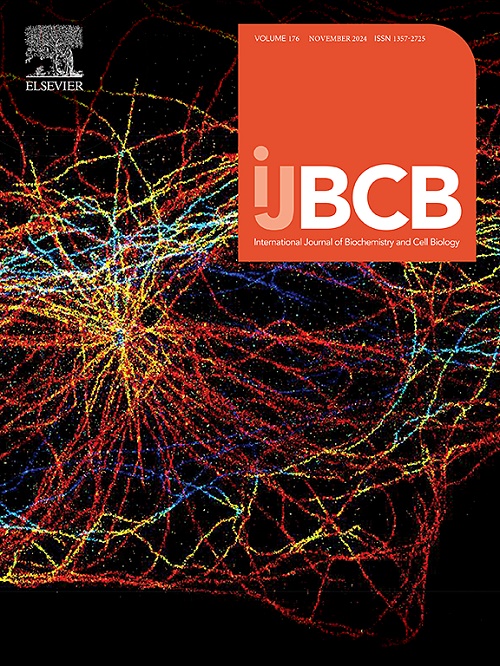Escin通过促进自噬激活和紧密连接屏障恢复来缓解dncb诱导的特应性皮炎样症状。
IF 2.8
3区 生物学
Q2 BIOCHEMISTRY & MOLECULAR BIOLOGY
International Journal of Biochemistry & Cell Biology
Pub Date : 2025-09-22
DOI:10.1016/j.biocel.2025.106865
引用次数: 0
摘要
特应性皮炎(AD)是一种以皮肤屏障功能受损和免疫失调为特征的慢性炎症性皮肤病。自噬是一种依赖于溶酶体的降解途径,对去除不必要的成分至关重要,在维持细胞稳态中起着至关重要的作用。自噬缺陷与AD的发病机制有关,增强自噬活性是一种可行的治疗策略。本研究探讨了天然皂苷叶香素通过自噬激活改善AD的潜力。在IL-4和IL-13刺激的ad样细胞模型中,escin诱导HaCaT角质形成细胞自噬,并减轻紧密连接(TJ)屏障破坏。值得注意的是,沉默ATG7(一种重要的自噬相关蛋白)可以消除escin的屏障修复作用。此外,在2,4-二硝基氯苯(DNCB)诱导的AD小鼠模型中,escin治疗改善了AD样皮肤病变,减少了肥大细胞浸润,降低了促炎细胞因子IL-4、IL-13和IFN-γ的皮肤水平。Escin也恢复了表皮关键TJ蛋白Claudin-1和ZO-1的表达。机制上,escin促进了转录因子EB (TFEB)的核易位,上调了自噬和溶酶体生物发生相关基因的表达。这些保护作用与AMPK-mTORC1-TFEB信号通路的激活有关。总之,我们的研究结果表明,叶皂苷可以增强自噬并恢复皮肤屏障功能,这突出了它作为一种新的治疗阿尔茨海默病的药物的潜力。本文章由计算机程序翻译,如有差异,请以英文原文为准。
Escin alleviates DNCB-induced atopic dermatitis-like symptoms by promoting autophagy activation and tight junction barrier restoration
Atopic dermatitis (AD) is a chronic inflammatory skin disease characterized by impaired skin barrier function and immune dysregulation. Autophagy, a lysosome-dependent degradation pathway essential for removing unnecessary components, plays a crucial role in maintaining cellular homeostasis. Defective autophagy has been implicated in AD pathogenesis, and enhancing autophagic activity represents a viable therapeutic strategy. This study investigated the potential of the natural saponin escin to ameliorate AD through autophagy activation. We demonstrated that escin induced autophagy in HaCaT keratinocytes and mitigated tight junction (TJ) barrier disruption in an AD-like cell model stimulated with IL-4 and IL-13. Notably, silencing ATG7, an essential autophagy-related protein, abrogated the barrier-restorative effects of escin. Furthermore, in a 2,4-dinitrochlorobenzene (DNCB)-induced murine model of AD, escin treatment ameliorated AD-like skin lesions, reduced mast cell infiltration, and decreased cutaneous levels of the pro-inflammatory cytokines IL-4, IL-13, and IFN-γ. Escin administration also restored the epidermal expression of key TJ proteins, Claudin-1 and ZO-1. Mechanistically, escin promoted the nuclear translocation of transcription factor EB (TFEB) and upregulated the expression of genes involved in autophagy and lysosome biogenesis. These protective effects were associated with the activation of the AMPK-mTORC1-TFEB signaling pathway. Collectively, our findings indicate that escin enhances autophagy and restores skin barrier function, highlighting its potential as a novel therapeutic agent for AD treatment.
求助全文
通过发布文献求助,成功后即可免费获取论文全文。
去求助
来源期刊
CiteScore
8.10
自引率
0.00%
发文量
124
审稿时长
19 days
期刊介绍:
IJBCB publishes original research articles, invited reviews and in-focus articles in all areas of cell and molecular biology and biomedical research.
Topics of interest include, but are not limited to:
-Mechanistic studies of cells, cell organelles, sub-cellular molecular pathways and metabolism
-Novel insights into disease pathogenesis
-Nanotechnology with implication to biological and medical processes
-Genomics and bioinformatics

 求助内容:
求助内容: 应助结果提醒方式:
应助结果提醒方式:


